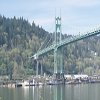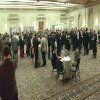Softwood plywood celebrates centennial
27 June 2010It was a gathering of the plywood clan assembled by APA-The Engineered Wood Association and the Plywood Pioneers Association to recall those initial, virtually hand-made, wonders.
John Murphy, APA board chairman, recalled at a morning dedication at the site of the long-gone mill on the bank of the Willamette River: “It was here in 1905 that Portland Manufacturing Company – a small wooden box factory – assembled by hand a primitive, three-ply panel for display at the Lewis and Clark World’s Fair held that year in Portland. As history records, several door manufacturers were impressed with the product, orders began to come in, and the plywood industry was off and running.”
Several descendants of Peter Autzen, one of the mill’s founding fathers, were there to help dedicate a commemorative plaque.
Bill Bennett, president of the Plywood Pioneers Association, said: “It is very gratifying to me personally, and to the entire membership of the Pioneers Association, to finally have this site permanently marked as the birthplace of our industry. I would like to give credit to Bill Keil, long-time industry trade journalist, who has been one of the most persistent advocates of this commemorative plaque project over the years.”
Chairman Murphy told the evening banquet audience of 300: “This is a great industry. We have played a significant role over the past century in building this country – and this entire continent – and we have contributed immeasurably to North American prosperity.
Most of us have been around this industry for a while. We’ve seen some good times and some bad times; we’ve seen history being made and we have made history.”
And for this, there were awards to veteran industry people. The Gustav Carlson Medal for Process Innovation was presented to Fred Fields of Coe Manufacturing Company. He was involved with Coe for 53 years, and owned the company for 23 years until retirement in 2000.
The Bronson Lewis Medal for Industry Growth, named for the executive vice president of the American Plywood Association, 1969 to 1984, was presented to Georgia-Pacific Corporation, the world’s largest softwood plywood manufacturer, with 19 mills in 10 US states..
Paul Ehinger and Don Dierdorff were joint recipients of W E Difford medals for industry contribution. Mr Difford was chief executive of the Douglas Fir Plywood Association for many years.
Mr Ehinger has worked in the forest industry for 50 years, was on the DFPA board for 18 years and president for two years.
Mr Deardorff began his plywood career as DFPA quality supervisor serving all the mills. After leaving the association he eventually formed a partnership to buy Fourply, Inc of which he later became sole owner.
He was elected to the APA board in 1970, where he served for 28 years and as chairman for two of those years. He was also president of the National Forest Products Association for two years.
As the 20th century emerged, the city of Portland, Oregon was becoming one of the leading centres of the US Pacific Coast forest industry. It was all based on the seemingly endless supply of huge, old-growth Douglas fir logs, many of them logged directly to the Willamette and Columbia rivers and rafted to the sawmills which then lined the Portland waterfront.
A century earlier, Thomas Jefferson, the third president of the US, struck a deal with France to buy two million km2 of what is now the nation’s heartland. He doubled the country’s size for US$15m in what has been described as the “greatest real estate deal in history”.
In 1804, he dispatched two army officers, Meriwether Lewis and William Clark, with a small party to check out his sight-unseen bargain. The two-year expedition journeyed to the Pacific Coast, where they wintered before returning homeward.
In 1905, the burgeoning city of Portland opted for a World Fair to celebrate the legendary journey and the then current industry. They attracted more than a million visitors. One of the draws was the huge hilltop Forestry Building built of mammoth fir logs. It was billed as the world’s largest log cabin.
To demonstrate Portland’s industrial sophistication, the organisers encouraged development of special products. They approached Portland Manufacturing Co and the result was plywood.
The theory of plywood was not new. Egyptians had used handmade veneer in their tombs thousands of years ago. And England, France, Scandinavia, China and Russia, among others, had worked with rudimentary plywood. The US Midwest had seen work with the product.
But Portland Manufacturing, which had produced boxes and packing materials, started the work in the Pacific Northwest. For a long period it would be the leading producing region.
That pioneering production was strictly a three-ply hand operation. A six-man crew used a St Joe lathe to peel veneer. They dried it in a lumber steam dry kiln and used animal glue warmed over a coal fire and swabbed onto the sheets with hand brushes.
The crew cobbled together a wooden press using hand operated house jacks to apply pressure. A single press load could be laid up in a day and pressing took all night.
The hand made plywood was displayed in the 105ft x 209ft Forestry Building which burned in a huge 1964 fire, destroying all the contents.
Portland Manufacturing itself had the same fate in 1910, but reopened the same year. More modern equipment was installed in line with changing technological times.

